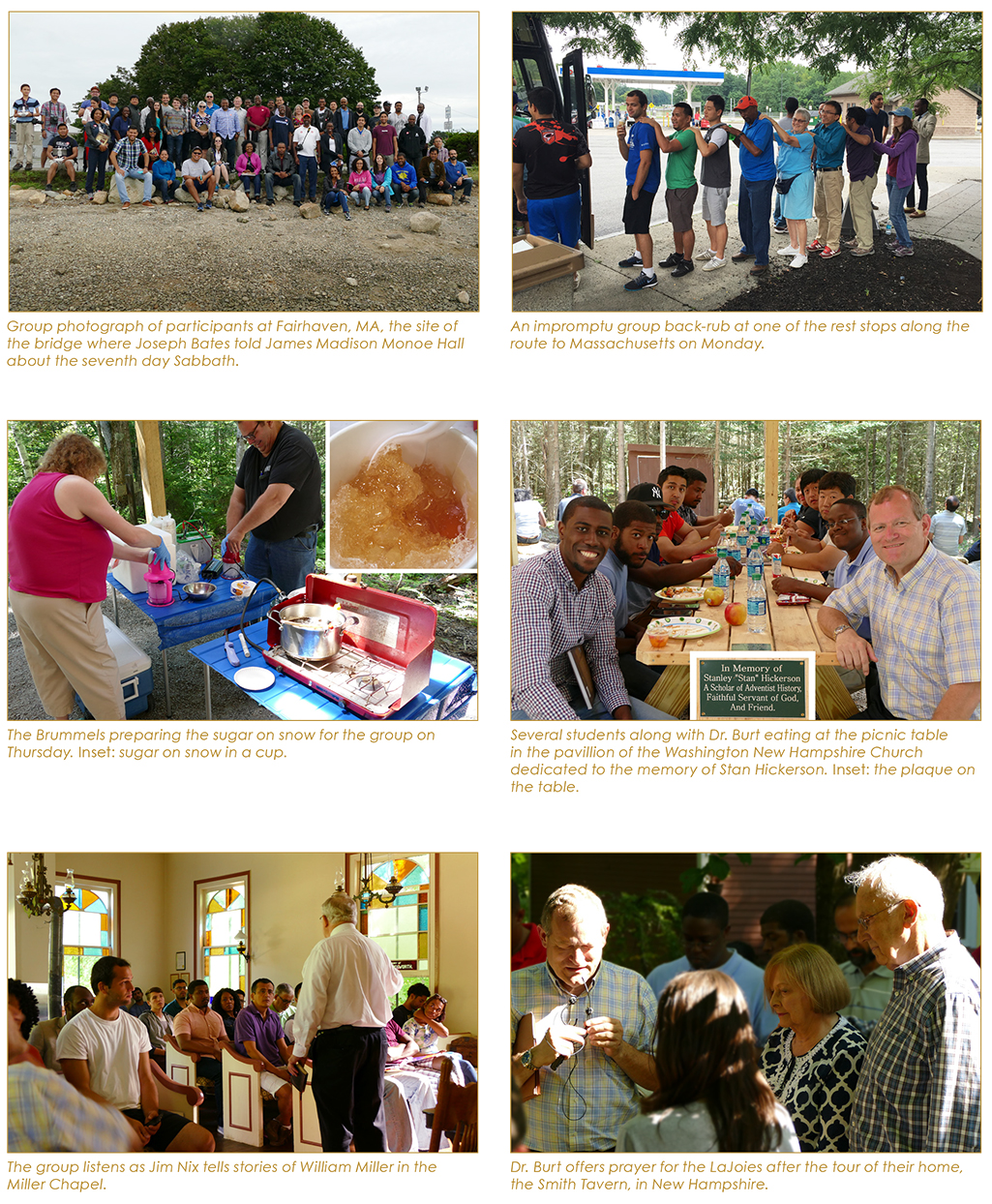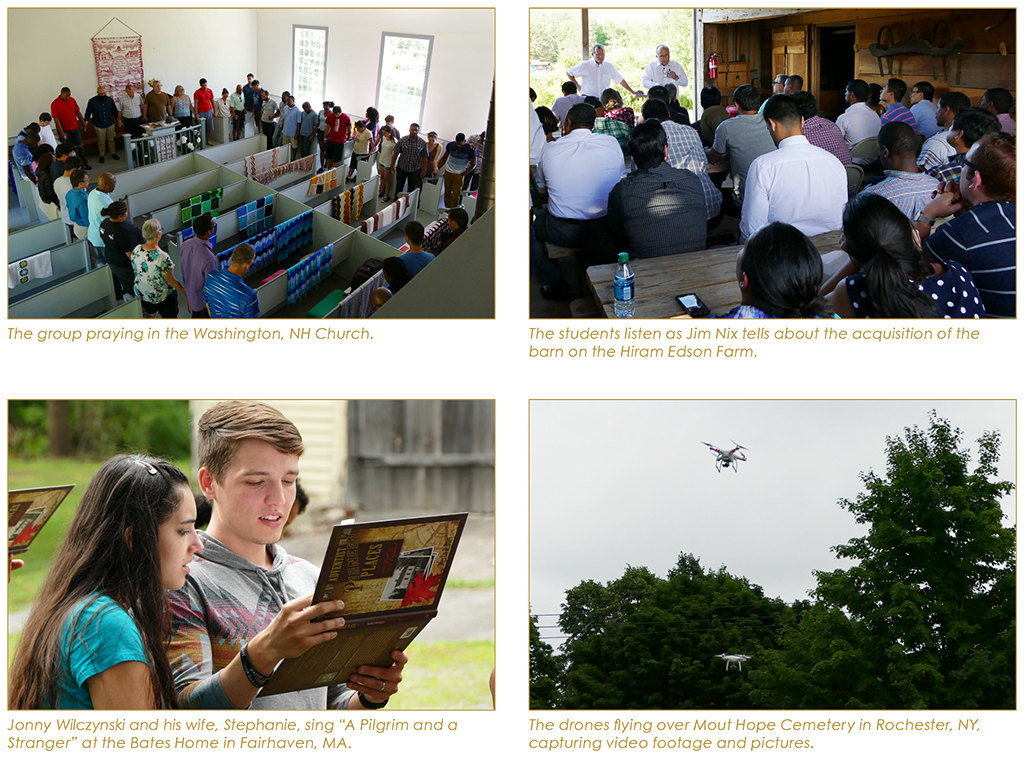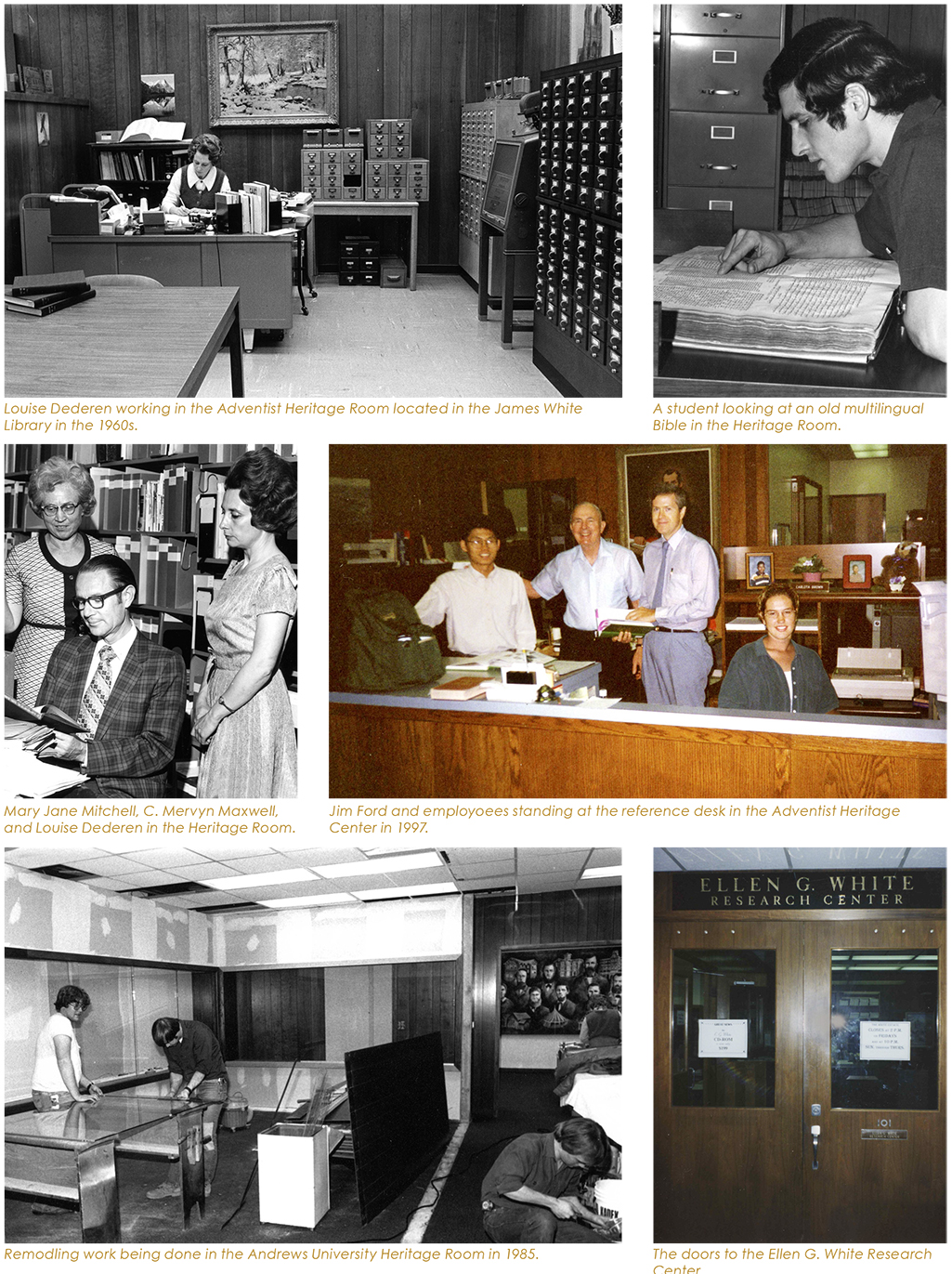A coach bus full of students began the journey to tour Adventist Historic sites in New York and New England from July 31 to August 8, 2016. This is an annual event for students of the Seventh-day Adventist Theological Seminary. Many find it a way to connect with the roots of the Seventh-day Adventist church. Rosimayre Barreiros reflected on her experience and said, “This experience of visiting the places where they walked and reading about the pioneers, especially Ellen G. White, was a life transformation for me. What I valued most from this tour was the understanding of their faith in God’s word, their love for God, and their willingness to sacrifice all to proclaim truth.”
On Monday, in Rochester, New York, the students toured Mount Hope Cemetery to see the graves of Mary Andrews, Angeline Andrews, Carrie Andrews, Nathaniel White and Anna White, and Frederick Douglass. Two attendees flew private drones they had brought along to capture footage and photos for a video of the tour sites. Afterward. the bus drove around the city to see historic sites, and then began the trip to Massachusetts. Lunch was served in the parking lot of a Walmart, and then we were back on the road to Ludlow for the night.
The following day the study tour went to Old Sturbridge Village and sites related to Joseph Bates. Old Sturbridge Village puts people into the mindset of life in the 1830s. That was a few years earlier than the events we focus on during the tour, but a good place to start to get a feel for how daily life was lived for our Adventist pioneers.
Joseph Bates, one of the co-founders of the Seventh-day Adventist church, grew up in Fairhaven, Massachusetts. His childhood home was near enough to the Atlantic to see the ocean-going vessels in the harbor and it is easy to understand how Bates developed a longing to go to sea. Bates spent 20-plus years at sea and retired as captain of his own ship with a comfortable fortune. The tour went to the home that he built upon his retirement which was later sold to fund the spread of the Millerite Advent message. Along the rocky water’s edge, where the old Fairhaven Bridge once stood, participants heard the story of how the Sabbath being the seventh day of the week came to the Millerites and to Joseph Bates. Bates then wrote three tracts on the Sabbath, one of which James and Ellen White read and were convinced to start keeping the seventh day of the week as the Sabbath.
Wednesday, the tour went to Maine; the house was pointed out where James and Ellen White were living when they accepted the Sabbath. This was in Gorham, Maine, while the Whites were living with Ellen’s parents in 1847. Gorham, Maine, is also where Ellen was born. She spent many of her growing up years in Portland, Maine. The tour visited many sites in Portland, but because of a fire in the 1860s and construction of newer buildings, many of the sites are uninspiring. For example, the spot where Ellen Harmon was baptized is now a parking lot because the city reclaimed land from the bay.
Thursday was spent in New Hampshire. First was a visit to the Washington, New Hampshire, Seventh-day Adventist church, which features the Sabbath Trail on its property. The group spent the morning in the church hearing stories and singing songs. Lunch was served with a special treat from the Brummels—sugar on snow. This consisted of shaved ice topped with boiled down maple syrup that hardened over the ice. During lunch, several students along with Dr. Burt were privileged to eat at the picnic table dedicated to the memory of Stan Hickerson. After lunch, a walk along the Sabbath Trail and picture taking time, the tour moved on to the childhood home of Uriah Smith and his sister Annie Smith. The LaJoies, owners of the Smith tavern, opened their home for a tour. Everyone enjoyed seeing the restored tavern. Annie Smith’s grave is in a cemetery nearby, near her family members.
That evening, the group ate at the Country Life Restaurant in Keene, New Hampshire. This is an independent, Adventist owned, vegan restaurant. Many on the tour considered it to be the best meal of the trip. It was a learning experience for many who were not familiar with the health ministry of these restaurants. It served as an anchor for the lectures about the health message given to the Seventh-day Adventist Church.
Friday was spent at the William Miller Farm and chapel. Elder Jim Nix, president of the White Estate, joined us to present the story of William Miller in the chapel. With passion and exhortation he described Miller’s conversion. He held up a cannon ball as a visual aid in describing the war of 1812 and the battle in which Miller took part. Later Elder Nix presided over the tour through Miller’s home.
Sabbath morning the group was at the Roosevelt Seventh-day Adventist Church for the worship service and then Sabbath School. Dr. Burt spoke for the worship service and the church was blessed to have the group. A very delicious lunch of haystacks and pie was served and pita pocket feast was prepared for a to-go supper. After a visit to the Roosavelt Cemetery, the bus was loaded and off to the Hiram Edson barn. After getting off the highway, the bus was delayed by a small-town parade. After about a 15 minute wait, the tour was back en route to the barn before heading back to Rochester, NY for the night.
Sunday’s journey back to the University was uneventful; all were thankful for safe travels and the good weather experienced over the whole week.
______________________________________________________________
In Their Own Words . . . Students Reflect
Previous to this Adventist study tour, my journey with Seventh-day Adventist history and the pioneers had been a most fulfilling one. I thoroughly enjoy history and what it teaches us about our present experience. The study tour was everything that I had hoped for from the aspect of causing me to dig deeper into our distinctive truth. In addition, I have a greater appreciation of the humanity of our pioneers and the wide range of emotions they experienced. The tour made me feel closer to the pioneers which enabled me to more fully appreciate their sacrifice and contribution to the Advent Movement. I find myself reading their writings with more depth of understanding and more empathy.
— Jim John
I honestly did not know what to expect from this journey of Adventist Heritage. I was not born into the church and cannot recall a major emphasis on Ellen White when I was prepared for baptism in 1998. In my undergraduate program at Griggs University, I was introduced to historical Adventist classes that had me read books on our heritage, but I was still unmoved as to our history. Coming to the Seminary in 2015 to obtain my MDiv lead me to study more about Ellen White, but honestly, I just saw her as superfluous. Therefore, when I came on this heritage tour, I was not expecting to be transformed by our heritage and history.
For me, it began as Dr. Burt demonstratively displayed a passion I had not seen in any Seminary professor. While I sat there in the front row of the Washington, NH Church, I was transfixed by the presentation of our history. It was presented in such a way that I was moved to realize the importance of our heritage and history. I used to think that historical sites were the epitome of soporific realities, however, I am of a different opinion after the tour.
In essence, this trip to New England has changed my life as a Seventh-day Adventist. I am no longer simply a Seventh-day Adventist minister. I am now Pastor Howard Tello, a Seventh-day Adventist, heritage loving, history reading, vegetarian loving, Ellen White reading minister!
— Howard Tello




